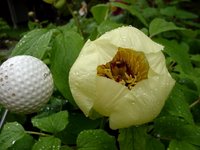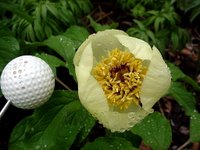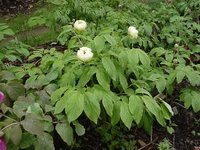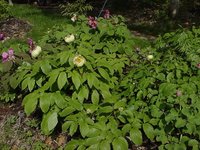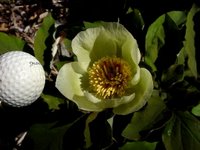 Very similar, and probably well within natural variability, Paeonia macrophylla is a synonym of Paeonia steveniana which we saw a few days back. Both are subsumed by some botanists into P. wittmaniana subsp. macrophylla.
Very similar, and probably well within natural variability, Paeonia macrophylla is a synonym of Paeonia steveniana which we saw a few days back. Both are subsumed by some botanists into P. wittmaniana subsp. macrophylla.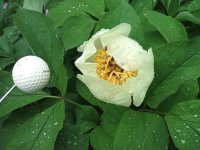 My plants are grown from seed which was collected at a botanical garden in the Rep. of Georgia, from plants grown from wild-collected seed. The species (subspecies if you prefer) is native to a small area of the Caucasus in that country, where it grows in mountain forests and subalpine meadows.
My plants are grown from seed which was collected at a botanical garden in the Rep. of Georgia, from plants grown from wild-collected seed. The species (subspecies if you prefer) is native to a small area of the Caucasus in that country, where it grows in mountain forests and subalpine meadows. It's a striking plant with large lush green leafs with a noteable vein pattern. Large creamy flowers, which retain a globe shape. First date of bloom 31 May here this year.
It's a striking plant with large lush green leafs with a noteable vein pattern. Large creamy flowers, which retain a globe shape. First date of bloom 31 May here this year.Here, it differs from the steveniana I grow in a greener leaf with more noticeable veining, the flowers are paler, and it came into bloom 4 days later (there is about 3 days of overlap). These are botanically insignificant differences, although if the difference in bloom dates is stable it can be horticulturally worthwhile for the peonyphile to have both plants around, subject to space availability. For those with more limited space, I consider what I have as steveniana to be superior to my macrophylla, mainly for the flower colour.
_________________________
It's hard to believe I have been doing this for two weeks already! I knew I had a bunch of different peonies but this is beyond what I thought was going to flower this year.
On another note, I have had to change digital cameras recently, and am still going through some teething issues with it. The major thing is that it tends to overexpose except on very overcast days. I have been manually editing brightness and contrast to counteract that trend but not always with greatest success.
